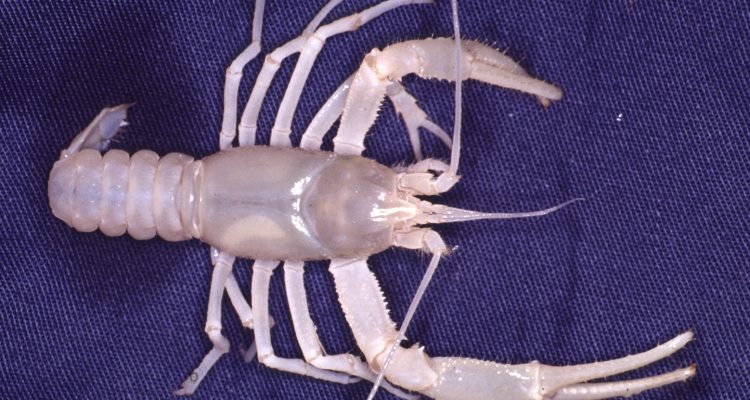
Cambarus aculabrum
Cambarus aculabrum NatureServe Explorer Species Reports — NatureServe Explorer is a source for authoritative conservation information on more than 50,000 plants, animals and ecological communtities of the U.S and Canada. NatureServe Explorer provides in-depth information on rare and endangered species, but includes common plants and animals too. NatureServe Explorer is a product of NatureServe in collaboration with the Natural Heritage Network.
ITIS Reports — Cambarus aculabrum ITIS (the Integrated Taxonomic Information System) is a source for authoritative taxonomic information on plants, animals, fungi, and microbes of North America and the world.
FWS Digital Media Library — The U.S. Fish and Wildlife Service’s National Digital Library is a searchable collection of selected images, historical artifacts, audio clips, publications, and video.
Cambarus aculabrum is a rare species of crayfish known by the common name Benton cave crayfish. It is native to Arkansas in the United States, where it is known from only four locations. It is a federally listed endangered species of the United States.
This crayfish was first described to science as a new species in 1987. It is about 48 millimeters (1.8 inches) long. A troglobite, it lacks pigment, making it white in color, it and has only rudimentary eyes. It is genetically distinct from other species of cave crayfish.
The crayfish lives at four caves in northern Arkansas, three in Benton County and one in Washington County. It is not considered an Arkansas endemic species because 58% of one of the Benton County cave zones is actually within the neighboring state of Missouri although it has not yet been found in Missouri.
This crayfish feeds on organic matter washed into the cave from the surface, and on bat guano. It is sometimes eaten by the banded sculpin (Cottus carolinae). Little else is known about its ecology.
Threats to this species include direct mortality when they are trampled by cave explorers and trespassers. Gates have been put in place at the caves to protect them but vandalism is still a threat. Pollution of the groundwater in the caves was the main reason the animal was federally listed. Individuals are sometimes washed out of caves during floods, leading to mortality.
| Status | Date Listed | Lead Region | Where Listed |
|---|---|---|---|
| Endangered | 04/27/1993 | Southeast Region (Region 4) | Wherever found |
- States/US Territories in which the Cave crayfish, Wherever found is known to or is believed to occur: Arkansas , Missouri
- US Counties in which the Cave crayfish, Wherever found is known to or is believed to occur: View All
- USFWS Refuges in which the Cave crayfish, Wherever found is known to occur: Logan Cave National Wildlife Refuge
- Countries in which the the Cave crayfish, Wherever found is known to occur: United States
| 07/29/2008 | 73 FR 43947 43948 | 5-Year Status Review of 20 Southeastern Species |
| 04/27/1993 | 58 FR 25742 25746 | ETWP; Endangered Status Determined for the Cave Crayfish Cambarus Aculabrum |
| 05/26/1992 | 57 FR 21929 21933 | ETWP; Proposed Endangered Status for the Cave Crayfish Cambarus aculabrum; 57 FR 21929 21933 |
| 12/29/1988 | 53 FR 52745 52746 | Notice of Finding on Petition to List an Ozark Cave Crayfish & an Idaho Snail; 53 FR 52745-52746 |
| 10/30/1996 | Cave Crayfish/Cambaras aculabrum (NCN) | View Implementation Progress | Final |
| 10/30/1996 | Cave Crayfish/Cambaras aculabrum (NCN) | View Implementation Progress | Final |
| 07/29/2008 | 73 FR 43947 43948 | 5-Year Status Review of 20 Southeastern Species |
|
| 05/10/2013 | 5-Year Review: Summary and Evaluation for Benton County Cave Crayfish (Cambarus aculabrum) |












